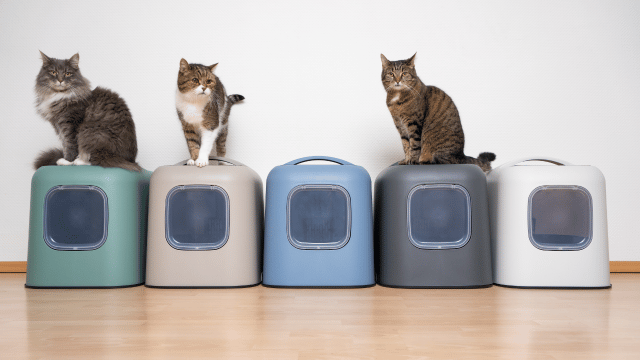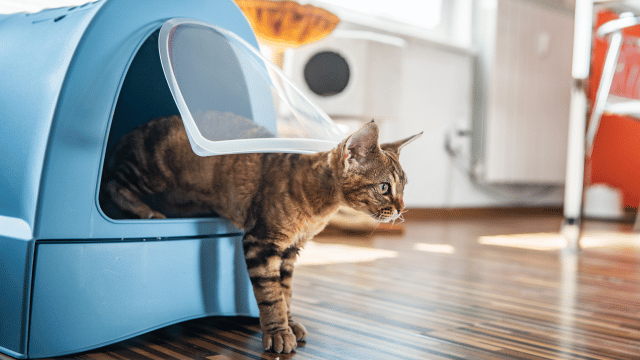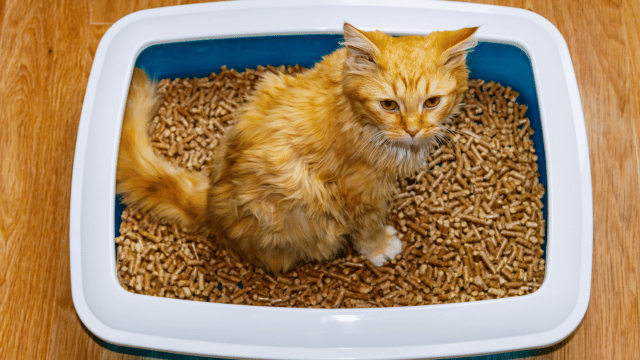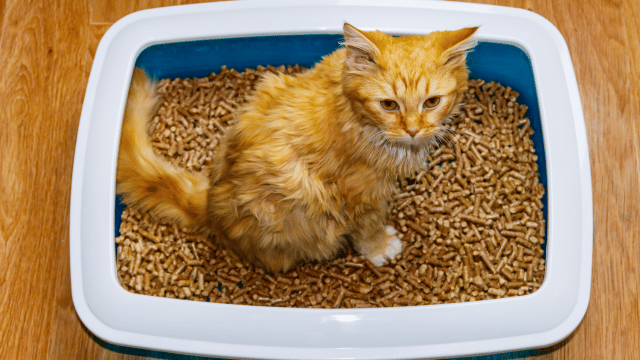Firstly, discover essential cat litter box solutions, ensuring a clean and stress-free environment for your feline friends. A vital guide for every cat owner.
Understanding Your Cat’s Litter Box Preferences
Understanding your cat’s litter box behavior is crucial. Often, issues arise when the litter box doesn’t meet their preferences. It’s not just about cleanliness; size and location also play a significant role. Observing your cat’s habits provides valuable insights, helping you adapt to their needs. This approach can lead to a harmonious living environment for you and your cat.
In addition, cats are fastidious creatures, and their litter box is no exception. If they avoid it, it’s a clear sign something is amiss. Could it be the type of litter? Or perhaps the box’s cleanliness? Monitoring these aspects can prevent potential issues. Additionally, consider the box’s accessibility. A conveniently placed litter box, in a quiet and safe area, can make all the difference.
Regular maintenance is the key to solving litter box issues. A clean, odor-free litter box is more inviting for your cat. This means frequent cleaning and using the right type of litter. Also, having multiple litter boxes in multi-cat households can prevent territorial disputes. Remember, a happy cat means a happy home.
Addressing Behavioral Litter Box Challenges
However, behavioral issues can often manifest in litter box avoidance. Stress, anxiety, or changes in the household can disrupt a cat’s routine, leading to this problem. It’s crucial to maintain a stable environment. Introducing changes gradually and providing a safe space for your cat can help mitigate stress. This approach fosters a sense of security, encouraging proper litter box usage.
Medical issues, although less common, can also influence litter box behavior. If your cat suddenly changes its habits, it’s wise to consult a veterinarian. Early detection of health problems can not only resolve litter box issues but also save your cat from discomfort. Partnering with a ‘cat friendly’ vet ensures your furry friend receives the best care, keeping them healthy and happy.
Finally, it’s essential to understand the link between litter box issues and a cat’s past experiences. Rescue cats, for example, may need extra patience and care. Creating a nurturing environment, with multiple litter options, can help them overcome past traumas. Consistency and patience are key in helping them adjust and feel comfortable in their new home.
Cat Litter Box Solutions for Every Home

To illustrate, choosing the right litter is a pivotal step in resolving litter box issues. With a plethora of options available, it’s about finding what works best for your cat. Some prefer clumping litter for its ease of cleaning, while others might lean towards natural options. Experimenting with different types can reveal your cat’s preference, ensuring they are comfortable and more likely to use the litter box consistently.
Litter box placement is another aspect often overlooked. Cats prefer a quiet, private spot, away from their food and water. A corner in a less-trafficked room often works well. Additionally, make sure the box is easily accessible, especially for older cats or those with mobility issues. Thoughtful placement of the litter box can significantly improve your cat’s adherence to using it.
Regular cleaning of the litter box is non-negotiable. Cats are clean animals and a dirty litter box can deter them from using it. Scooping the litter daily and changing it completely every week is a good practice. Also, washing the box with mild soap and water during litter changes keeps it fresh and inviting. Maintaining cleanliness is a simple yet effective solution to many litter box issues.
Effective Training Techniques for Litter Use
Training your cat to use the litter box may seem daunting, but with the right techniques, it can be a smooth process. Start by placing your cat in the box after meals and naps, as these are times they’re most likely to go. Gentle encouragement and positive reinforcement can make a significant difference. Remember, patience is key; never punish your cat for accidents outside the box.
Cats learn by association, so creating positive associations with the litter box is essential. You can do this by ensuring the box is always clean and placing it in a quiet, undisturbed area. If your cat uses the box successfully, offer them a treat or affection as a reward. This reinforces the behavior, making them more likely to repeat it.
Also, if your cat resists using the litter box, consider its design. Some cats prefer open boxes, while others like the privacy of a covered one. The depth of the litter can also be a factor; some cats dislike litter that’s too deep. Experimenting with different styles and litter depths can help you find the perfect match for your cat’s preferences.
Identifying and Solving Litter Box Odors
Litter box odors can be a significant issue for cat owners, but they’re also a sign that something needs attention. Good odor control starts with the litter you choose. Some litters are specifically designed to neutralize odors, which can make a noticeable difference. However, the key to odor control is not just in the type of litter but in regular maintenance and cleanliness.
Beyond the litter itself, consider the litter box’s environment. Good ventilation is crucial in minimizing odors. A poorly ventilated area can trap odors, making the environment unpleasant for both you and your cat. If possible, place the litter box in an area with some airflow, but ensure it remains a quiet and private space for your cat.
For persistent odor issues, for example, adding baking soda to the litter can help. It’s a natural odor absorber and is safe for cats. Sprinkle a little on the bottom of the litter box before adding litter. Also, consider a litter box liner for easier cleaning. Remember, a fresh and odor-free litter box is more appealing to your cat, encouraging proper use.
Balancing Multi-Cat Households and Litter
In multi-cat households, managing litter box usage can be a challenge, but it’s not insurmountable. On the other hand, the general rule is one litter box per cat, plus one extra. This ensures that each cat has its own space, reducing territorial stress. Also, placing the litter boxes in different locations can prevent any one cat from monopolizing all the boxes, which can happen in multi-cat dynamics.
Observing each cat’s litter box preference is also crucial. Some cats might prefer certain types of litter or litter boxes over others. In a household with multiple cats, it’s important to cater to these individual preferences to maintain harmony. This may involve a trial and error approach, but finding the right combination can significantly reduce litter box issues.
Conflict resolution is another aspect to consider. If one cat is bullying another away from the litter boxes, it can lead to stress-related avoidance. Creating a safe and accessible environment for each cat is essential. This might involve separate feeding areas, hiding spots, and ensuring each cat has its own litter box. A peaceful coexistence is key to a well-functioning multi-cat home.
Optimizing Litter Box Location and Setup

As a result, the location of a litter box can greatly influence a cat’s willingness to use it. Cats prefer a quiet, secluded spot, away from the hustle and bustle of household traffic. Avoid placing the litter box near noisy appliances or areas that receive a lot of foot traffic. A calm, accessible location makes your cat feel safe and undisturbed while using their box, encouraging regular use.
Notably, size and accessibility of the litter box are also key factors. Ensure the box is large enough for your cat to move around comfortably. For kittens and older cats, a box with lower sides is essential for easy access. Additionally, if you have a multi-level home, consider placing a litter box on each floor to prevent accessibility issues, especially for older cats who might find stairs challenging.
The setup inside the litter box is just as important. The depth of the litter should be sufficient for your cat to dig and cover their waste, usually about two to three inches. Some cats have preferences for certain types of litter, so be observant and ready to adapt. Keeping these elements in mind can greatly enhance your cat’s litter box experience.
Cat Litter Box Solutions for Busy Owners
Busy cat owners often struggle with maintaining a clean litter box, but there are solutions. Automated litter boxes are an excellent option for those with a hectic schedule. These boxes self-clean after each use, reducing odor and the need for daily scooping. However, it’s important to gradually introduce your cat to these new devices, as some may be hesitant at first due to the noise and movement.
Another time-saving solution is using high-quality clumping litter. For instance, it makes cleaning easier and more efficient, as waste clumps together and can be scooped out quickly. Additionally, investing in a larger litter box can reduce the frequency of cleanings. With more space, cats are less likely to soil the edges or overfill the box, making maintenance less frequent but equally effective.
Lastly, consider setting a reminder for regular litter box maintenance. Even with time-saving measures in place, a litter box requires regular cleaning to prevent odors and maintain a hygienic environment. Regularly replacing the litter and washing the box with mild, cat-friendly cleaners can prevent odors and keep your cat happy and healthy.
Preventing and Addressing Litter Box Accidents
Accidents outside the litter box can be frustrating, but they’re often a sign of underlying issues. First, rule out any medical problems by consulting with a veterinarian. If health issues aren’t the cause, consider the cleanliness and location of the litter box. A dirty litter box or one placed in a noisy or high-traffic area can dissuade your cat from using it.
Addressing accidents involves more than just clean-up. It’s important to remove odors thoroughly to prevent your cat from returning to the same spot. Use an enzymatic cleaner specifically designed for pet accidents, as it effectively breaks down the odor-causing bacteria. Also, providing an additional litter box in a different location can offer your cat an alternative, which might be more to their liking.
Consistency is key in preventing future accidents. Maintain a regular cleaning schedule for the litter box and monitor your cat’s behavior for any changes. If accidents persist, consider environmental stressors or behavioral issues. Providing a stable, calm environment and possibly consulting with a cat behaviorist can help resolve these issues, leading to a happier cat and a cleaner home.
IN SUMMARY
Then, caring for your cat’s litter box needs is an integral part of responsible pet ownership. Throughout this article, we’ve explored various cat litter box solutions, emphasizing the importance of understanding your cat’s preferences and behaviors. Whether it’s selecting the right type of litter, finding the optimal box location, or managing a multi-cat household, each aspect plays a critical role in ensuring your cat’s comfort and happiness.
Remember, consistency in cleaning and maintaining the litter box is key. Regular upkeep not only promotes good hygiene but also encourages your cat to use the box properly. If challenges arise, approach them with patience and a willingness to adapt. Sometimes, small changes in the litter type or box placement can make a significant difference.
In conclusion, a well-maintained litter box contributes to a harmonious home where both you and your cat can thrive. By understanding and catering to your cat’s needs, you foster a loving, stress-free environment. Always be observant and responsive to changes in your cat’s litter box behavior, as it can be an indicator of their overall well-being.
II. Frequently Asked Questions About Dog and Cat Behavior
- How do cats and dogs behave differently?Cats and dogs exhibit distinct behaviors due to their evolutionary backgrounds. Dogs, being pack animals, are generally more social and eager to please, often seeking attention and approval from their owners. Cats, on the other hand, are more independent and territorial, showing affection on their terms.
- How do dogs act with cats?Dogs may act curiously or playfully with cats, especially if socialized properly. However, their behavior can vary widely based on the dog's breed, temperament, and previous experiences with cats.
- Will a cat and a dog get along?Yes, a cat and a dog can get along with proper introductions and training. Their relationship often depends on their individual personalities and the way they are introduced to each other.
- Why does my dog have cat behavior?Some dogs may exhibit behaviors typically associated with cats, such as grooming themselves or being more solitary, which could be due to individual personality, breed traits, or environmental influences.
- What is a pet behaviorist?A pet behaviorist is a professional who specializes in understanding and modifying animal behavior through various techniques, often addressing issues like aggression, fear, or anxiety in pets.
- Are animal behaviorists worth it?Yes, animal behaviorists can be incredibly valuable, especially for addressing complex behavioral issues, improving pet-owner relationships, and ensuring the well-being of the pet.
- What is a behavioral vet?A behavioral vet, or veterinary behaviorist, is a veterinarian who specializes in diagnosing and treating behavioral issues in animals, combining medical and behavioral science.
- What is a cat behavior consultant?A cat behavior consultant specializes in understanding and addressing behavioral issues in cats, offering tailored advice to resolve problems like aggression, litter box issues, or excessive meowing.
- How do I train my dog to behave around cats?Training a dog to behave around cats involves gradual introductions, positive reinforcement for calm behavior, and setting clear boundaries to ensure safe interactions.
- Can I train my dog and cat to get along?Yes, with patience and consistent training, you can encourage positive interactions and mutual respect between your dog and cat, fostering a peaceful coexistence.
See more

Join Dan Morgan at dwfocus.com, your hub for ‘4 paws and owners’ wisdom! Explore a world where pet care meets expert insights, crafted by Dan, a seasoned vet with a heart for animals. Engage with stories, tips, and advice that every pet owner needs. From playful pups to graceful cats, Dan Morgan guides you through the joys and challenges of pet parenting. Embrace your love for pets with Dan’s expert guidance on dwfocus.com. #4PawsAndOwners #DanMorganPetExpert #dwfocus









